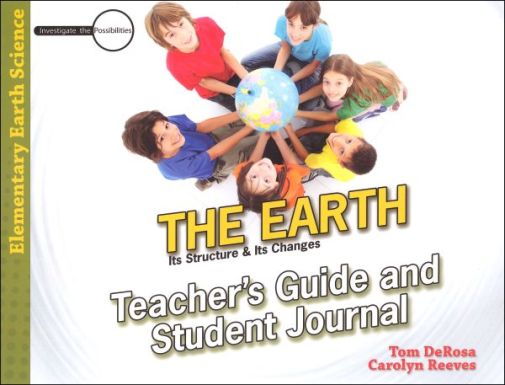We use cookies to make your experience better. To comply with the new e-Privacy directive, we need to ask for your consent to set the cookies. Learn more.
Earth: Its Structure & Its Changes Teacher's Guide & Student Journal
This elementary science program uses an extremely hands-on and interesting approach for students in grades 3-6 to get a thorough understanding of the physical and chemical laws at work in God's Creation. The series incorporates creation apologetics and mini Bible lessons in with science concepts to help students understand how science works according to God's plan and His word.
The multi-step, systematic approach employed by this series has 6 steps: engage, investigate, explain, apply, expand, and assess. Each lesson uses the 6 steps to engage students from beginning to end.
Think About This is the engage step of the lesson and presents the concept to be taught. The information is presented in small amounts so that the page isn't visually overwhelming to students, and it is written in age-appropriate language without being watered down. The investigate portion includes 3 sections The Investigative Problem, Gather These Materials, and Procedure & Observations. These sections work together to tell students what to look for, what materials they will need, and instructions for the activity and what and how to observe. The Science Stuff is the explain step that tells what happened in the investigation using a scientific explanation. Making Connections is the apply step which tells how the science knowledge is related to other situations and ideas. The expand step is found in Dig Deeper which provides an opportunity for students to expand what they have learned by doing another project. There may be 3 or 4 choices for these projects. Students in 3rd and 4th grade should do at least one project per lesson for a total of 20 projects per semester. Students in 5th and 6th should complete at least 25 projects per semester. The last step is the assess step which is titled What Did You Learn. This is where students will answer questions about the content of the lesson.
Each Lesson Book in the series includes 20 lessons, one lesson or investigation per week, which means one book should take about one semester to complete. Students will learn about scientists from different periods in history, read informative narratives, and be given the opportunity for skits or dramas taken from their research. The bright, colorful texts in this series will really hold the attention of middle grade students.
The Teacher Guide for each Lesson Book begins by offering an explanation of this program and a note to the teacher. The pages include small-format student pages along with the objective for each lesson, special instructions for the investigations, follow-up discussion questions, additional activities, and answer key.
The Student Journal offers a place for students to record information from the investigations, projects, ideas, and reflections. There are graphs for special projects, questions to help students better understand science, charts to help simplify studies, and guidance for the Digging Deeper activity. Note pages are found at the back of the book for additional information a student may want to write.
Newly available supplements include Teacher Guides from Master Books, which provide a weekly lesson schedule (180 lessons), reproducible quizzes & tests (2 levels), quiz/test answer keys, and master supply list.
Forces & Motion investigates physical science and earth science. Topics include acceleration, buoyancy, gravity, density, energy, force, friction, inertia, lift, mass, potential energy, pressure, speed, and weight. Students will also learn about Archimedes, Bernoulli, Galileo, and Isaac Newton. Subtitled "From High-speed Jets to Wind-up Toys," it holds fun activities like observing and recording wind-up toys, spinning tops, toy cars, catapults and more. Matter covers chemistry using household items. Students will learn about bubbles, water, colors, salt, and the periodic table. Energy: Its Forms, Changes & Functions simplifies the physics of all types of energy such as wind, solar, and nuclear. Earth: Its Structure & Its Change, covers earthquakes, volcanoes, minerals, rocks, weathering, caves, glaciers, and the soil. The teacher guide and student journal are combined for this title. Water & Weather covers everything water from the beginning and creation of fossils, evaporation and the water cycle, God's system of purifying water, and weather instruments. Universe: From Comets to Constellations is the most recent in the series and is a great earth & space study. Learn about Kepler & Galileo, the universe and the planets within, earth and its atmosphere, the moon, and constellations. This series offers an alternative to some of the programs already available. The reading is presented at grade level, so students can do their own reading, and hands-on opportunities abound. It's not only interesting for students, but it is easy for parents and teachers to implement. There is a certain ‘Gravitas' feel to the program, but presented from a Biblical worldview and a smaller price tag. ~ Donna
| Product Format: | Softcover Book |
|---|---|
| Brand: | New Leaf |
| Grades: | 3-6 |
| ISBN: | 9780890515921 |
| Length in Inches: | 8.5 |
| Width in Inches: | 11 |
| Height in Inches: | 0.25 |
| Weight in Pounds: | 0.55 |

